- What Is Review Schema Markup?
- Why Review Schema Is Important
- Getting Rich Snippets
- Social Proof
- The SEO Benefits
- Review vs. AggregateRating Schema Required Properties
- Simple Reviews
- Simple Review Schema Required Properties
- Aggregate Ratings
- AggregateRating Schema Required Properties
- How to Implement Review Schema on Your Website
- How to Implement AggregateRating Schema on Your Website
- How to Nest Simple Reviews and Aggregate Ratings
- How to Add Review Schema at Scale
- Adding Schema Manually
- Using Schema Plugins
- Guidelines to Be Aware of
- How to Test Your Review Schema
- Schema Markup Validator
- Rich Results Preview Testing
- How to Measure the Impact of Review Schema
- Method 1: Using the Semrush Organic Research Tool
- Method 2: Using Google Search Console
- Monitor Your Structured Data Implementation at Scale with Semrush
What Is Review Schema Markup?
Review schema is a type of structured data markup that provides search engines like Google with details about reviews and ratings for products, recipes, movies, and more.
Search engines may use this markup to display user reviews and ratings within search results.
For example, the first waffle recipe shown in the image below uses review schema to display user ratings in the form of stars.
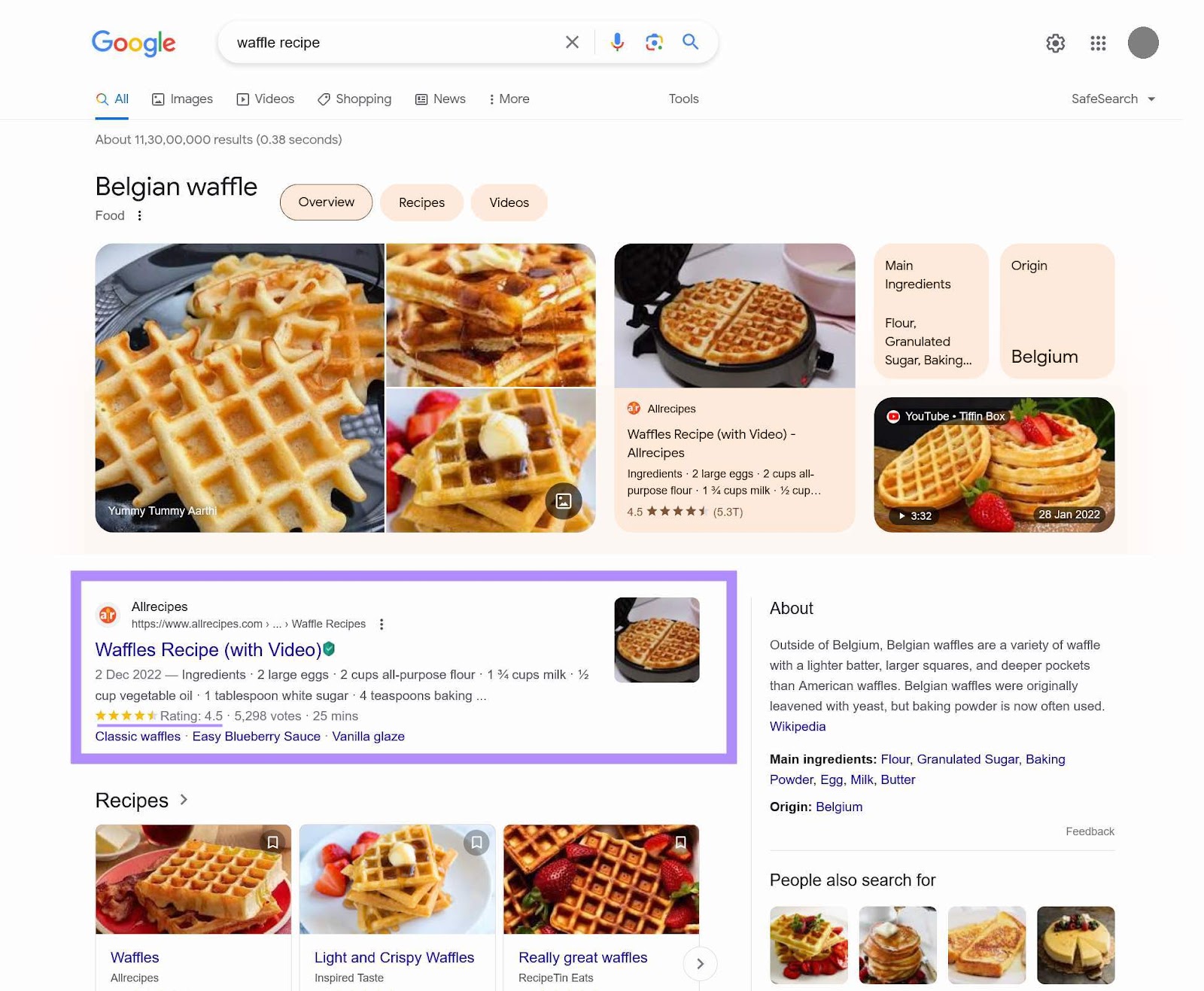
Review schema is one of the many types of schema markup that search engines like Bing and Google support and that is promoted by Schema.org.
In this guide, we’ll go through the benefits of using review schema, how you can add it to your website, and how to test your implementation.
Why Review Schema Is Important
Adding review schema to your website is important because it allows you to leverage social proof to capture users’ attention in search results. It can be useful for showcasing reviews of your own products or recipes in search results, or when you’re reviewing things yourself.
Getting Rich Snippets
Review schema markup can visually enhance your listing in search engine results pages (SERPs) by displaying a set of yellow star ratings (usually from one to five). This creates what is known as a rich snippet (or rich result).
These yellow stars provide contrast to all the plain text found in search results. Catching the eyes of users. This is especially important in mobile search results, as the yellow stars take up a larger proportion of the overall screen space.
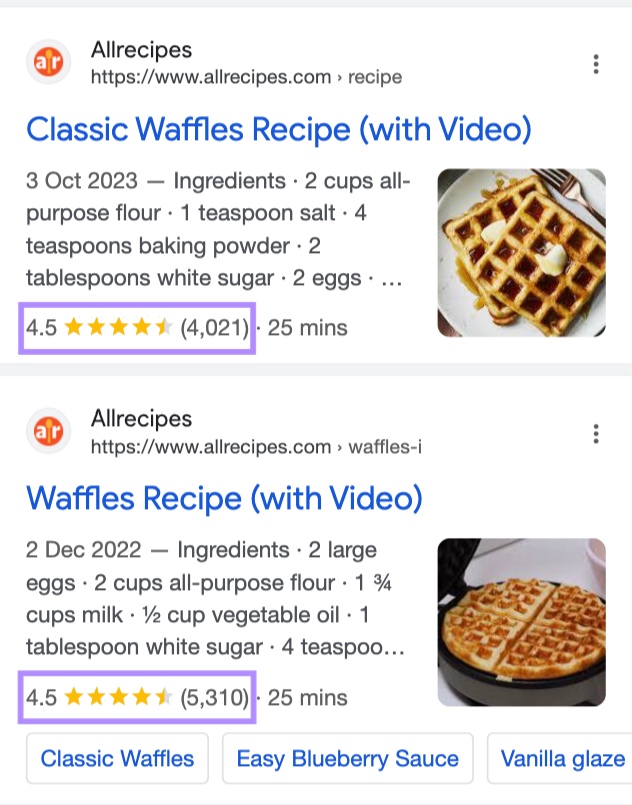
Social Proof
Aside from the potential visual enhancement in the SERP, using review schema and potentially getting a rich snippet in search results also adds social proof. Your product can have a star rating within the search results based on real user feedback.
Both the social proof and enhanced visual presence in search results can improve the chances of users clicking on your website and potentially making a purchase.
The SEO Benefits
Schema is not a confirmed Google ranking factor. Adding review schema to your pages will not directly affect your rankings.
However, review schema markup can help search engines better understand what your webpages are about. This could help Google understand what search queries are relevant to your content.
And this could indirectly impact what queries your content appears in search results for. But there’s no guarantee. And it won’t impact where in those results your content ranks. Having helpful, high-quality content is far more important for ranking.
But you can still benefit from the potential for rich snippets. And these can have a measurable impact on important metrics such as your click-through rate (CTR) and conversion rate.
Let’s now look at how you can implement review schema on your website.
Review vs. AggregateRating Schema Required Properties
You can add two types of review and rating schema to your webpages:
- Simple reviews: individual opinion provided by a user
- Aggregate ratings: an aggregate of multiple user reviews
They both have specific required properties you must include if you want your webpages to appear as rich snippets in search results. Google’s documentation goes into detail about these requirements, and we’ll look at them below.
Simple Reviews
The image below shows a simple review of an individual user rating a particular waffle cafe on Tripadvisor.com. Simple reviews like this help highlight an individual’s opinion about a product or service.

You’ll commonly see this schema type used for editorial reviews of products, like tech, books, and movies. Like this example for a review of the 15-inch MacBook Air:

Simple Review Schema Required Properties
|
Property |
Notes |
|
author |
Can be a Person or Organization |
|
itemReviewed |
Can be one of several valid types, including Book, Course, and Product |
|
itemReviewed.name |
The name of the item being reviewed (Text) |
|
reviewRating |
The rating provided in the review |
|
reviewRating. ratingValue |
The numerical quality rating for the item, which can be a number, fraction, or percentage (Number or Text) |
Google also recommends using the following properties:
- datePublished (the date the review was published, using the ISO 8601 format)
- bestRating (if omitted, 5 is assumed by default)
- worstRating (if omitted, 1 is assumed by default)
Aggregate Ratings
You can use the AggregateRating schema when you want to take the average of a selection of ratings from different users.
You’ll also see this type of review schema on editorial reviews where readers can have their say, but it’s also commonly used for showing reviews of businesses on sites like Facebook and Yelp.
The image below shows the aggregate ratings of over 5,000 users for a waffle recipe on allrecipes.com:

AggregateRating Schema Required Properties
|
Property |
Notes |
|
itemReviewed |
Can be one of several valid types, including Book, Course, and Product |
|
itemReviewed.name |
The name of the item being reviewed (Text) |
|
ratingCount |
Total number of ratings for the reviewed item (Number) |
|
reviewCount |
The number of reviewers (Number) |
|
ratingValue |
The numerical quality rating for the item, which can be a number, fraction, or percentage (Number or Text) |
As with the simple Review schema, Google recommends including bestRating and worstRating properties. If you don’t, Google will assume a 1-5 scale.
Now that you know the required properties, let’s go through how to add each type of review schema to your website. Starting with simple Review schema markup.
How to Implement Review Schema on Your Website
You can add both types of review schema to your website in multiple ways.
You can do so manually, by copying and pasting the schema you generate (see examples below) into the <head> section of the relevant pages.
Or you can use a schema plugin if you’re using a CMS like WordPress. There are also lots of schema generators out there that can make things easier if you’re a beginner. We’ll talk more about this later in the article.
Below is an example of simple Review schema that adds a four-star review to a waffle recipe page, using the required properties we discussed above. Google recommends using JSON-LD for schema markup, so that’s what we’ll use in all our examples below.
<script type="application/ld+json">
{
"@context": "https://schema.org/",
"@type": "Review",
"itemReviewed": {
"@type": "Recipe",
"image": "https://www.example.com/waffles.jpg",
"name": "Waffles"
},
"reviewRating": {
"@type": "Rating",
"ratingValue": "4",
"bestRating": "5",
"worstRating": "0"
},
"author": {
"@type": "Person",
"name": "Waffle Expert"
},
"datePublished": "2024-03-05"
}
</script>
Now, let’s see what AggregateRating review schema looks like.
How to Implement AggregateRating Schema on Your Website
As with the simple Review schema type above, you can implement AggregateRating schema on your website manually or with the help of plugins and schema generators.
Once again, we have a code snippet below that uses the required and recommended properties from earlier. In this case, we’re adding an aggregated rating of 8.6 across 5,500 user ratings for a different waffle recipe on www.example.com.
<script type="application/ld+json">
{
"@context": "https://schema.org/",
"@type": "AggregateRating",
"itemReviewed": {
"@type": "Recipe",
"image": "https://www.example.com/more-waffles.jpg",
"name": "More Waffles"
},
"ratingValue": "8.6",
"bestRating": "10",
"worstRating": "0",
"reviewCount": "5500"
}
</script>
In practice, unless you’re no longer accepting new reviews/ratings, you’ll ideally have a way of updating the ratingValue property as the number of reviews changes. You may need to use a plugin/API to do this for you (more on that later).
Now let’s look at how you can nest review schema within other schema types.
How to Nest Simple Reviews and Aggregate Ratings
To enhance the readability of your code and make the main focus of the page clear to search engines, you can also nest simple reviews and aggregate ratings within other schema types.
For example, you can nest simple review schema inside product information as shown below:
<script type="application/ld+json">
{
"@context": "https://schema.org/",
"@type": "Product",
"image": "https://www.example.com/waffle-iron.jpg",
"name": "Waffle Iron",
"review": ({
"@type": "Review",
"reviewRating": {
"@type": "Rating",
"ratingValue": "4",
"bestRating": "5",
"worstRating": "0"
},
"author": {
"@type": "Person",
"name": "Waffle Expert"
},
"datePublished": "2024-05-02"
})
}
</script>
As you can see, the above code snippet begins by putting the product information as our main type, and then uses the “review” property to add the review details.
Similarly, you can nest aggregate ratings as shown below:
<script type="application/ld+json">
{
"@context": "https://schema.org/",
"@type": "Product",
"image": "https://www.example.com/another-waffle-iron.jpg",
"name": "Another Waffle Iron",
"aggregateRating": {
"@type": "AggregateRating",
"ratingValue": "7.4",
"bestRating": "10",
"worstRating": "0",
"ratingCount": "367"
}
}
</script>
How to Add Review Schema at Scale
Adding Schema Manually
Once you generate your review schema markup in the forms illustrated in the previous section, you can add it to the <head> section of your HTML pages. Either manually within your website’s files or by using a code snippet plugin within your CMS.
But instead of manually adding review schema markup to each individual page on your website, you can use the following two methods to deploy review schema at scale.
Using Schema Plugins
Depending on your situation and preferences, you can use plugins to generate and/or implement your review schema.
A Chrome browser plugin like Schema.dev helps you mark up review schema without writing any code. However, you will need to manually add it to your pages.
If you have a WordPress website, you can use plugins to generate and add the schema for you. One option is Schema Pro’s review schema implementation.
In addition to implementing review schema, WordPress plugins can also help you implement other structured data assets. Such as article, event, and video schema.
Guidelines to Be Aware of
No matter how you add your review schema to your website, you need to abide by Google’s guidelines. These include:
- Reviews and ratings should be easy to find on the page you’ve marked up
- It must be immediately obvious to a user that the page contains review content
- Review information should be about a specific item rather than a category or list
- Include aggregate ratings of multiple individual reviews
- Don’t aggregate reviews/ratings from other websites
How to Test Your Review Schema
Both before and after implementing your review schema, it’s a good idea to test that you’ve generated it correctly.
Below are two tools you can use to validate and test your schema. Both of them will highlight errors in your code, and you can use Google’s error documentation to learn how to fix them.
Schema Markup Validator
Use Schema.org’s schema markup validator tool to validate your schema markup. The tool automatically highlights errors such as missing objects and names.
You can use this before you add the schema to your webpages to ensure everything is correct. By using the code snippet option, rather than entering the URL.
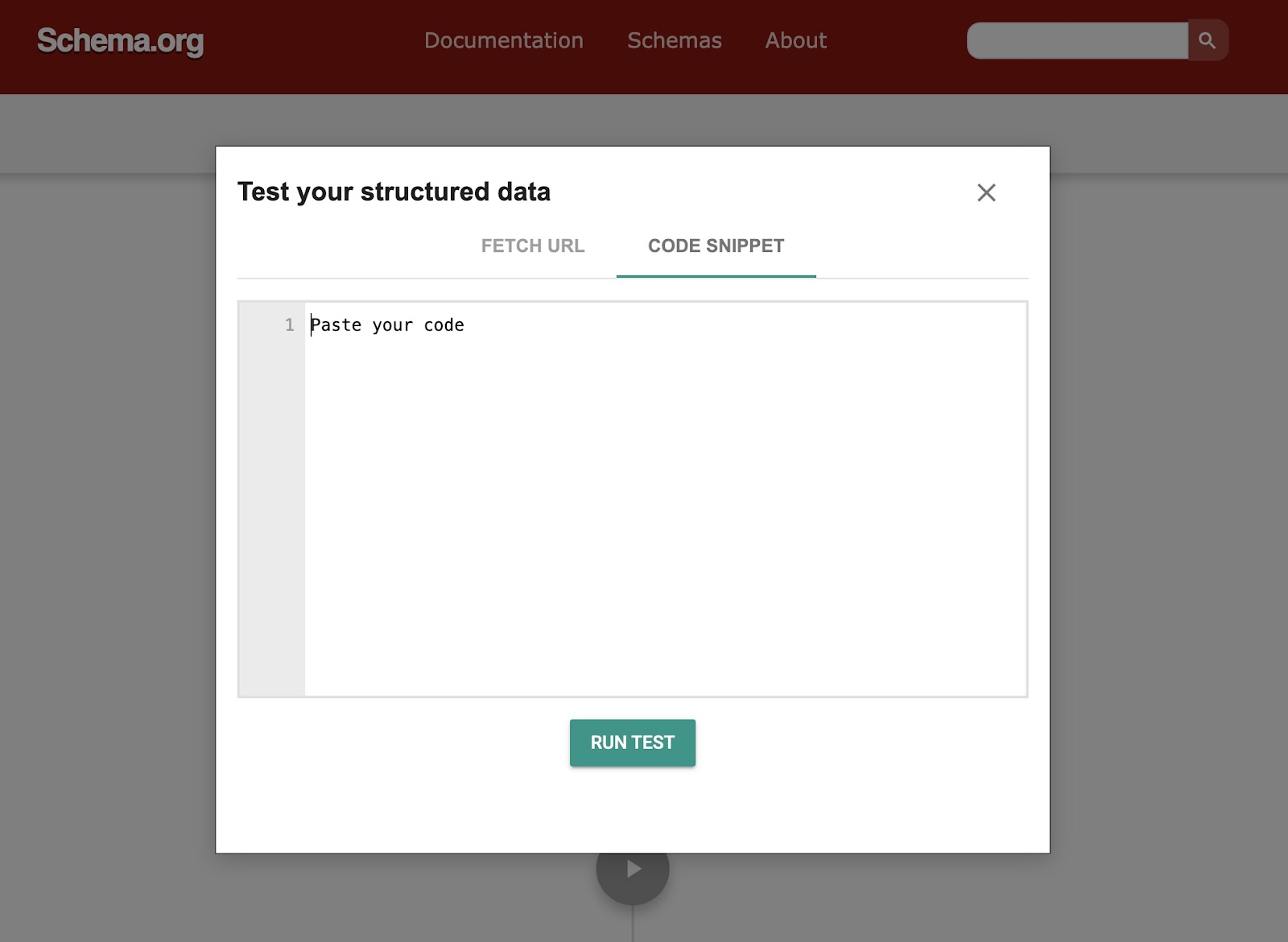
Rich Results Preview Testing
Google’s Rich Results Test is another tool you can use to validate your review schema. Like Schema.org’s tool, you can use this both before you implement the schema (using the code snippet option) and afterward to make sure you’ve added it correctly.
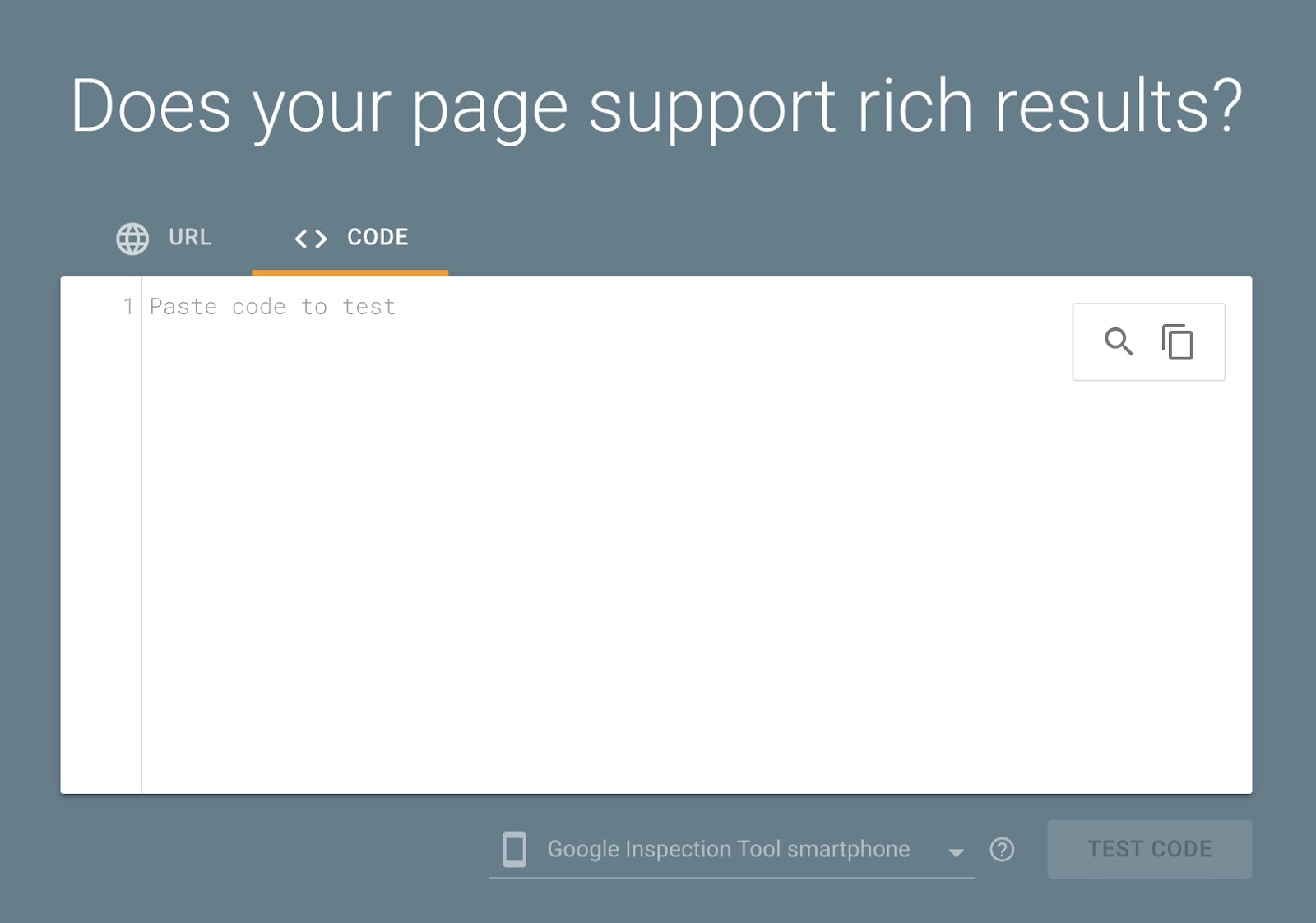
How to Measure the Impact of Review Schema
Implementing review schema on your website can have an impact on your click-through and conversion rates, and potentially an SEO impact as well.
But a lot of this relies on getting rich results in Google search. So how do you find out how well you’re performing after implementing review schema markup?
Method 1: Using the Semrush Organic Research Tool
You can use Semrush’s Organic Research tool to learn where your pages are appearing as rich results.
Navigate to the Organic Research tool from the left-hand navigation.
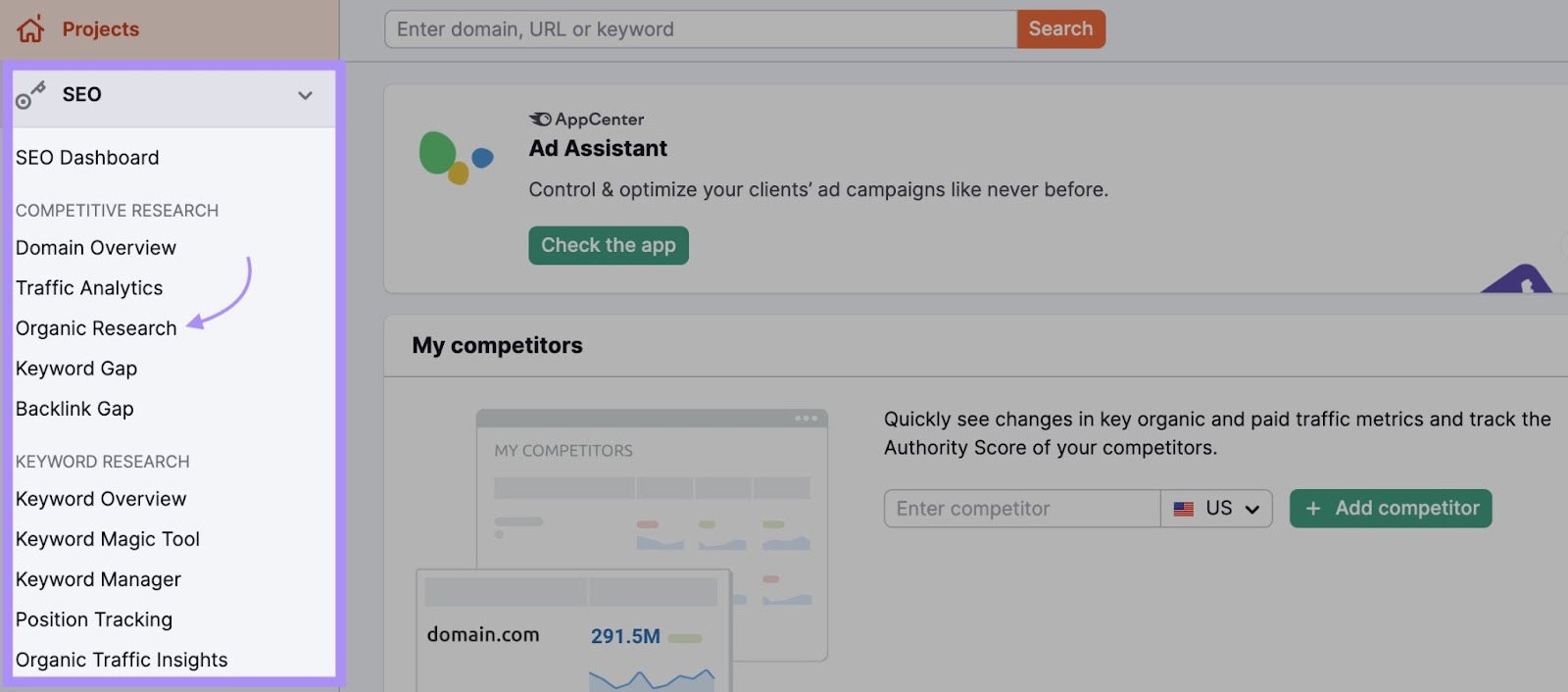
Enter the domain you want to analyze and click “Search.”

On the dashboard that appears, scroll down to the box named “SERP Features.” Click on the “Reviews” feature in the “Linking to domain” section.
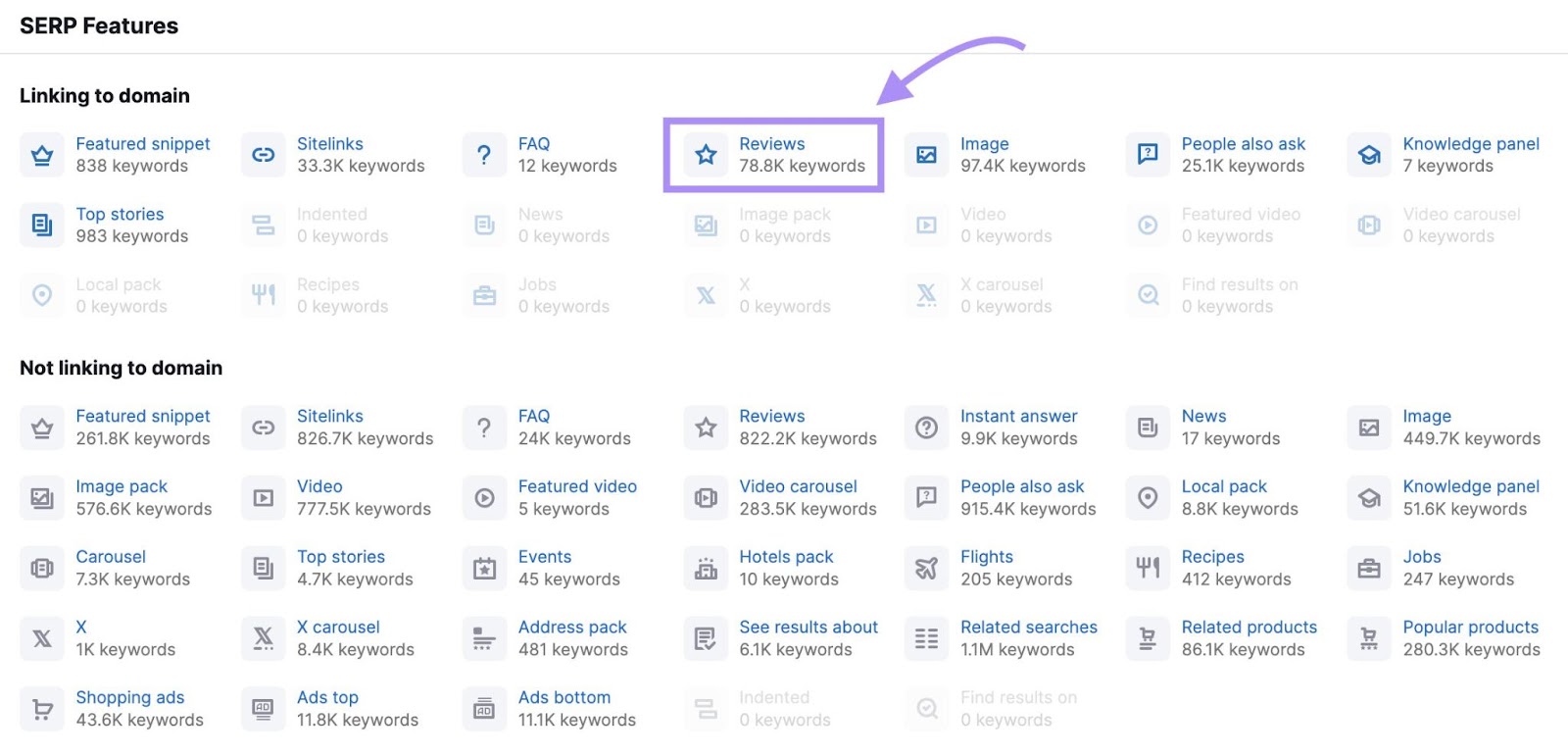
This will take you to a dashboard with all keywords for which your website ranks with a review rich snippet.
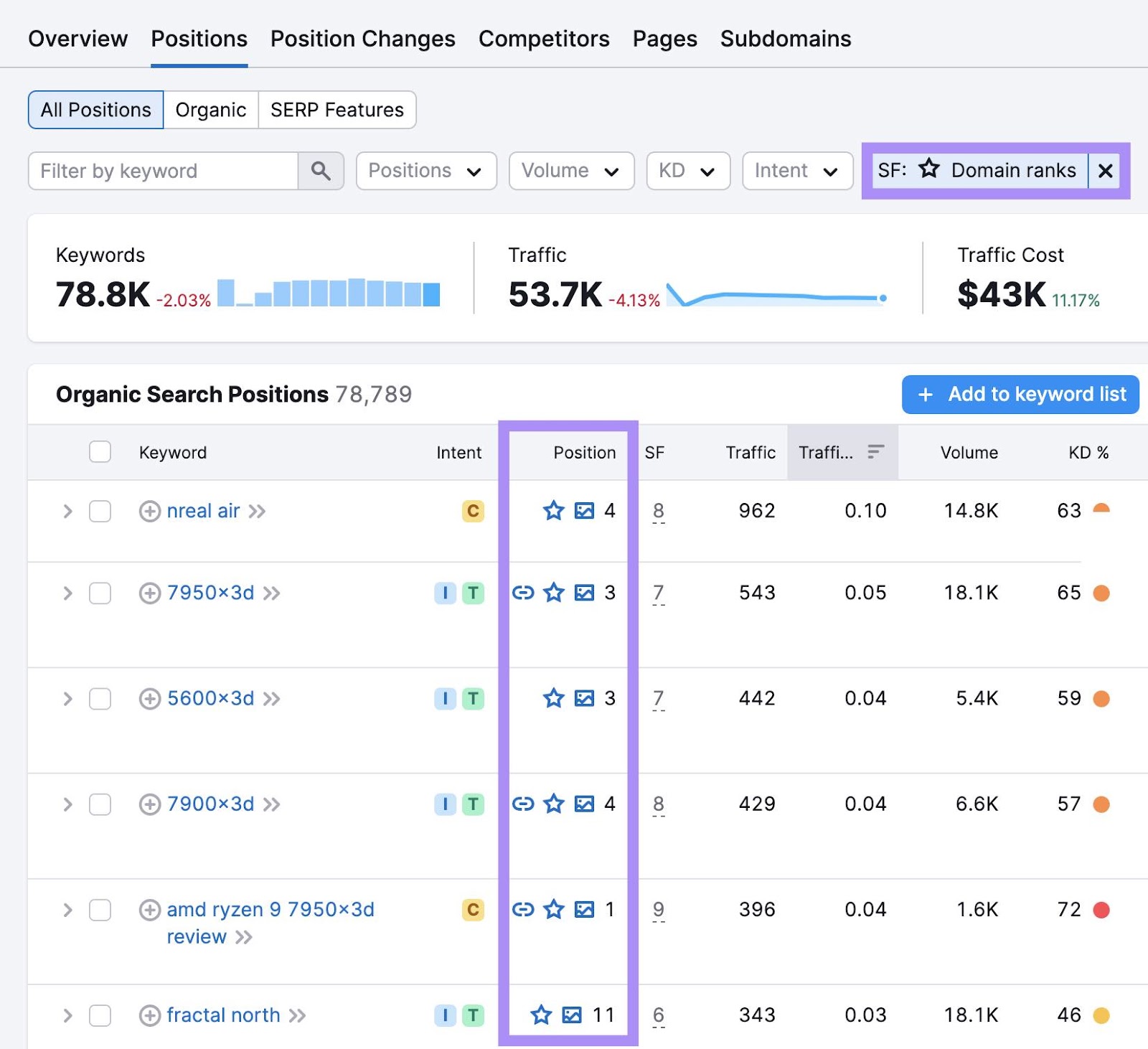
You can use this tool to monitor the number of keywords for which you’re ranking with a review rich snippet after implementing review schema. If you don’t see growth in this number over time, double-check your implementations.
However, the content on the pages also needs to be high quality for them to rank in SERPs. And you should follow other SEO best practices, too.
Method 2: Using Google Search Console
You can also use Google Search Console (GSC) to track the performance of your pages with rich results.
To find valid pages and those with errors, look under the “Enhancements” area of the menu on the left-hand side of your Google Search Console dashboard. As long as you have valid review snippets for the GSC property, an option to view a report will display here.
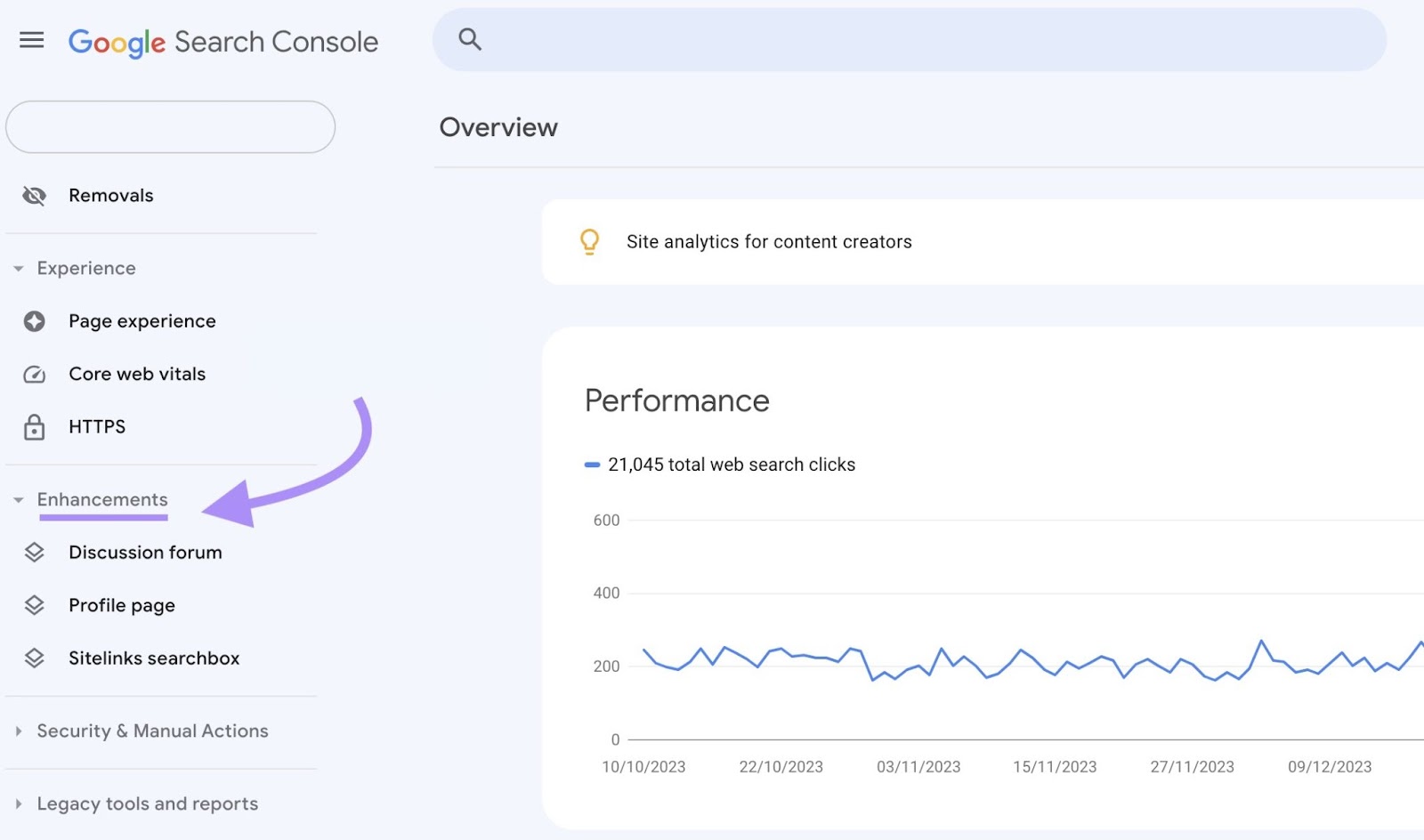
If you don’t see any review snippet option here after implementing your review schema (like the screenshot above), it could be due to one of the following reasons:
- You may have incorrectly implemented the review schema
- Google hasn’t crawled those pages yet
- Google deems those pages as invalid for review snippets
You can also find a performance report to see both the clicks and impressions for each snippet. To see this report, first navigate to “Search results” under the “Performance” tab on the left-hand side.
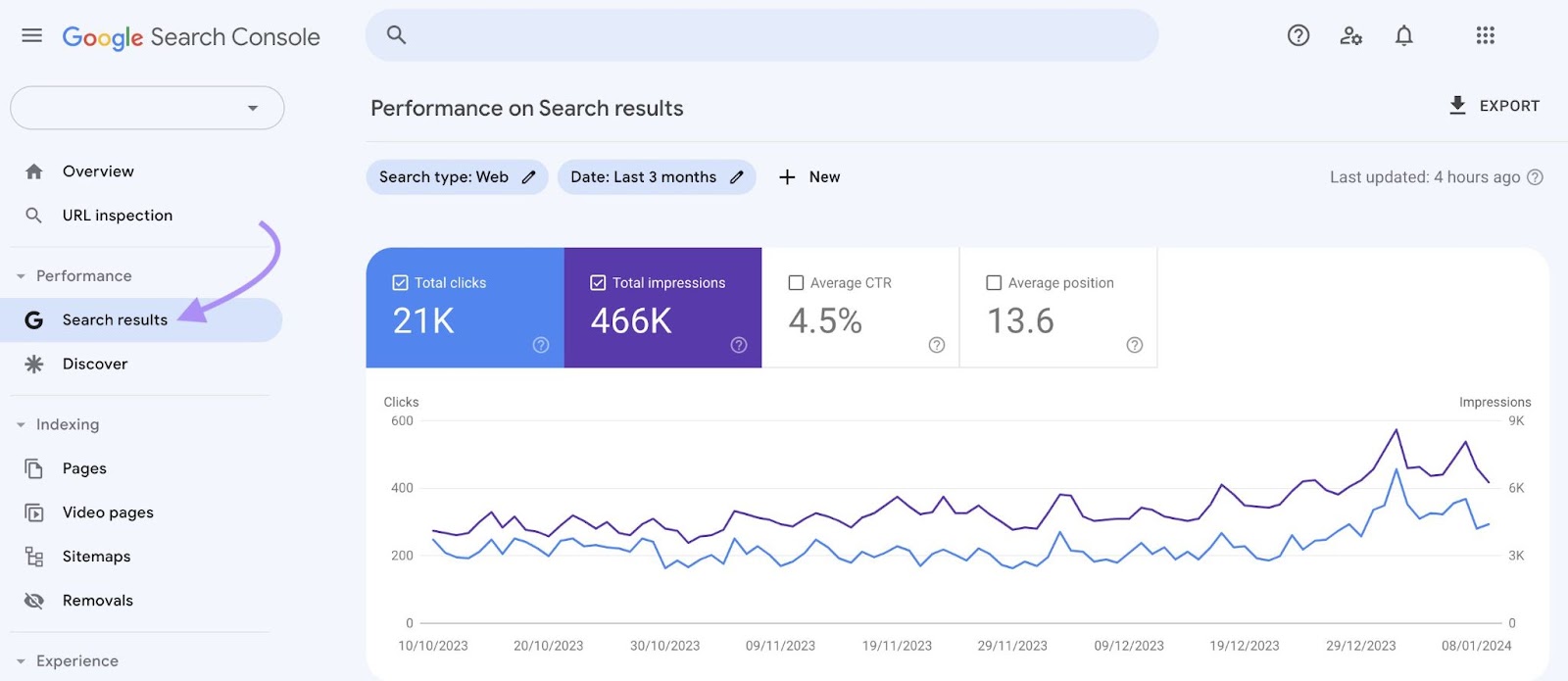
Next, add a search appearance filter by clicking the “+ New” button at the top. Choose “Search appearance…” from the menu that appears.
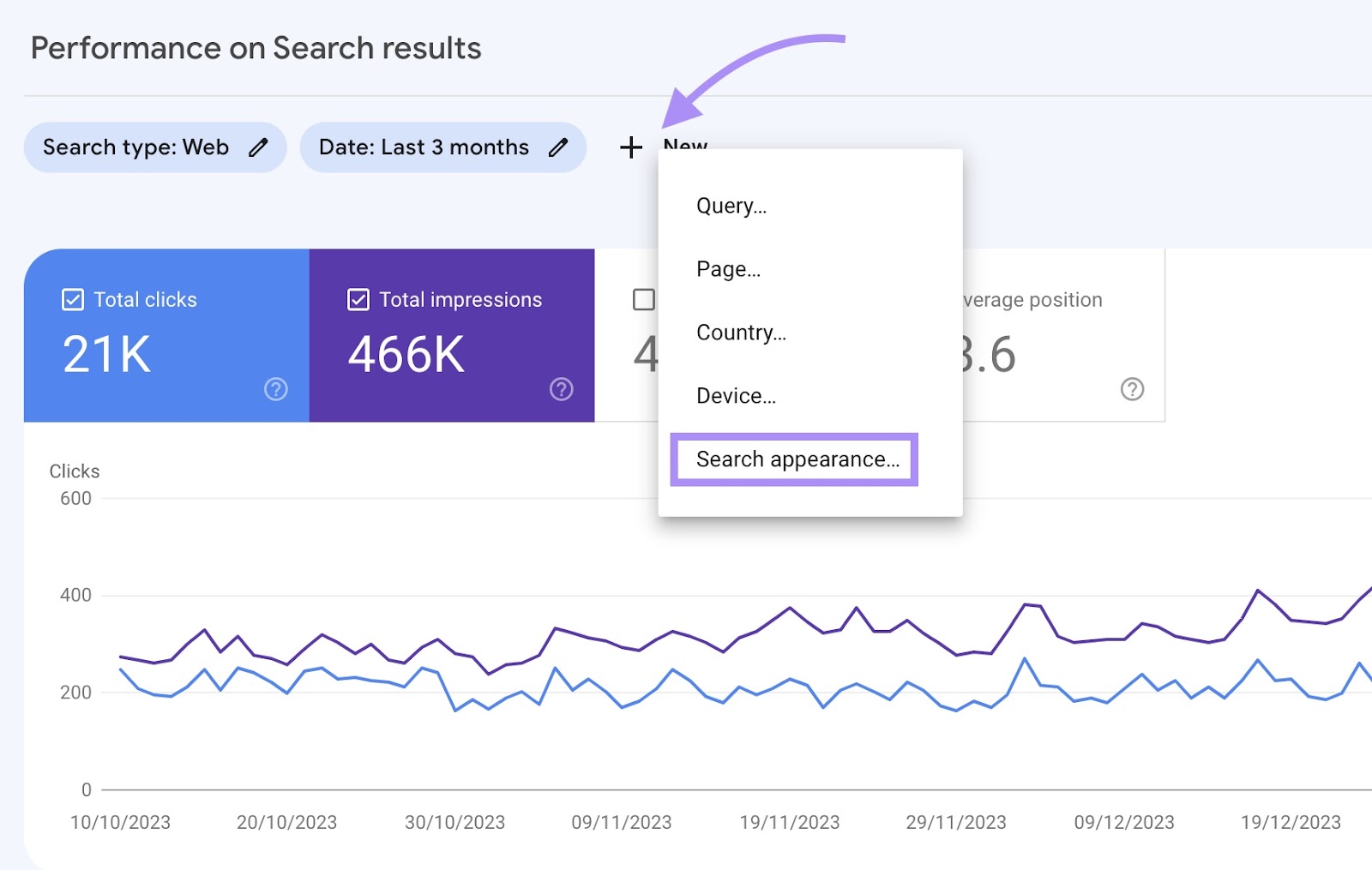
A box will appear where you can select the rich snippets for which you want to filter results. As before, if you have valid pages with review snippets, the review snippet option will appear here. Click that option.
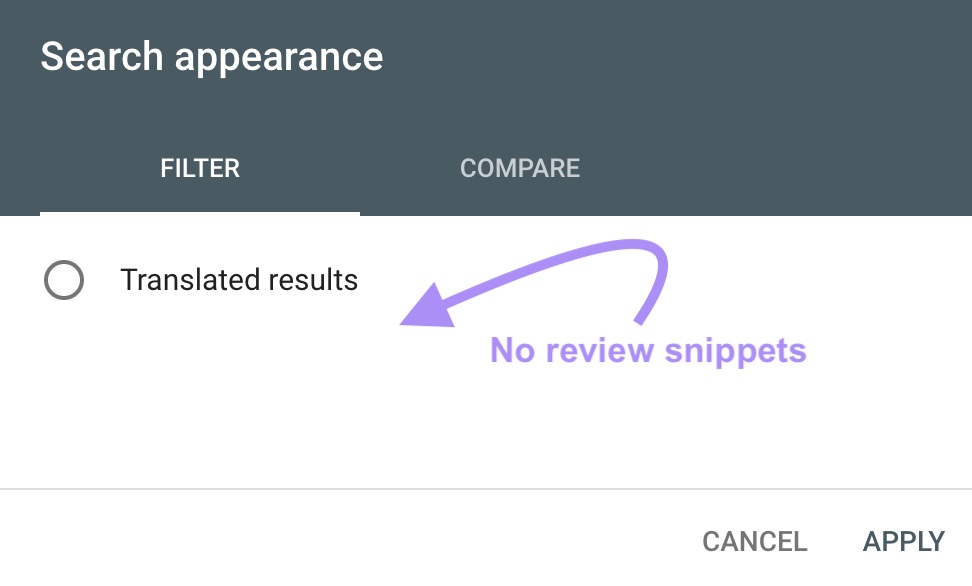
If you do have the review snippets option, click “Apply” to see a chart of clicks and impressions for all queries that led to review snippets appearing in the SERPs. You can then navigate to the pages report to see which pages have review snippets, along with clicks and impressions for each.
Monitor Your Structured Data Implementation at Scale with Semrush
It can be challenging to manage and monitor the implementation of structured data (like review schema) for websites with lots of pages to mark up. Along with every other aspect of keeping your website optimized.
The Semrush Site Audit tool provides an easy way to get an overview of your website’s health—including finding errors in your structured data markup.
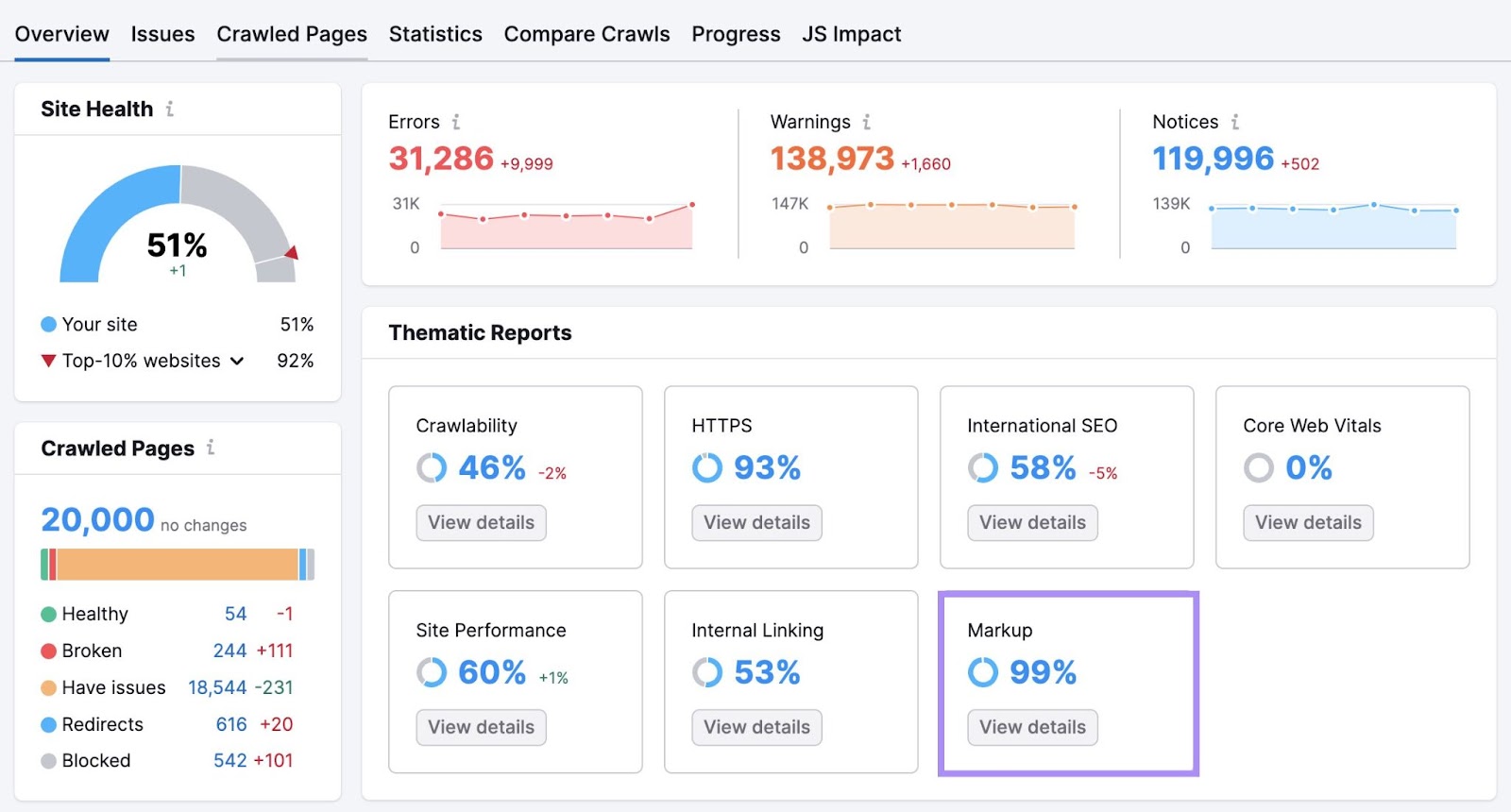
Site Audit also helps you understand how many of your pages use markup and how many of those marked-up pages have invalid structured data assets.
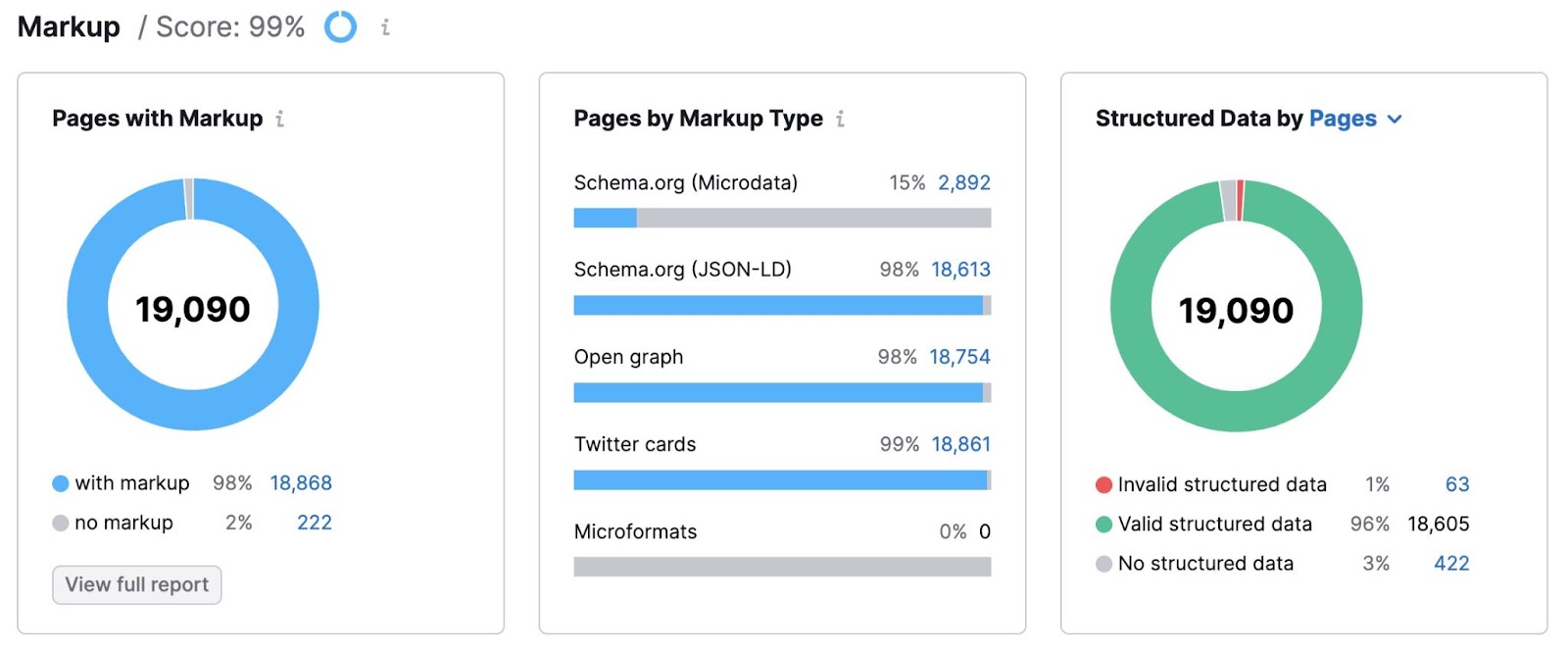
Check for structured data issues—and perform 140+ other on-page and technical SEO checks—with a free trial.
منبع: https://www.semrush.com/blog/review-schema/


